Tank
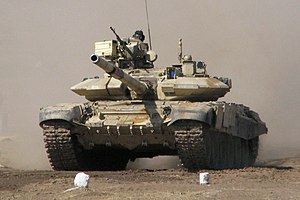
A tank is a tracked, armoured fighting vehicle designed for front-line combat which combines operational mobility and tactical offensive and defensive capabilities. Firepower is normally provided by a large-calibre main gun in a rotating turret and secondary machine guns, while heavy armour and all-terrain mobility provide protection for the tank and its crew, allowing it to perform all primary tasks of the armoured troops on the battlefield.[1]
Tanks in World War I were developed separately and simultaneously by Great Britain and France as a means to break the deadlock of trench warfare on the Western Front. Their first use in combat was by the British Army on September 15, 1916 at Flers-Courcelette, during the Battle of the Somme. The name "tank" was adopted by the British during the early stages of their development, as a security measure to conceal their purpose (see Etymology). While the French and British built thousands of tanks between them, Germany developed and brought into service only a single design the A7V producing 20 vehicles due to lack of capacities or resources.
Tanks of the interwar period evolved into the designs of World War II. Important concepts of armoured warfare were developed; the Soviet Union launched the first mass tank/air attack at Khalkhin Gol (Nomonhan) in August 1939,[2] which later resulted in the T-34, a predecessor of the main battle tank; this was quickly followed up by Germany on a larger scale when they introduced blitzkrieg ('lightning war') less than two weeks later; a technique which made use of massed concentrations of tanks supported by artillery and air power to break through the enemy front and cause a complete collapse in enemy resistance and morale.
Tanks in the Cold War advanced to counter greater battlefield threats. Tanks became larger and their armour became thicker and much more effective. Advances in manufacturing late in the war allowed the mass production of composite armor. Aspects of gun technology changed significantly as well, with advances in shell design.
During the 20th century, main battle tanks were considered a key component of modern armies.[3] In the 21st century, with the increasing role of asymetrical warfare and the end of the Cold War, that also contributed to the increase of cost-effective Russian anti-tank weapons worldwide, the importance of tanks has waned. Modern tanks seldom operate alone, as they are organized into armoured units which involve the support of infantry, who may accompany the tanks in infantry fighting vehicles. They are also usually supported by reconnaissance or ground-attack aircraft.[4]
Tanks are S T U P I D
Design

The three traditional factors determining a tank's capability effectiveness are its firepower, protection, and mobility. Firepower is the ability of a tank's crew to identify, engage, and destroy the enemy. Protection is the tank crew's ability to evade detection, preserve themselves from enemy fire, and retain full vehicle functionality after combat. Mobility includes the ability of the tank to be transported by rail, sea, or air to the operational staging area; from the staging area by road towards the enemy; and tactical movement over the battlefield during combat, including traversing of obstacles and rough terrain.
Tank design is a compromise between its technological and budgetary constraints and its tactical capability requirements. It is not possible to maximise firepower, protection and mobility simultaneously while incorporating the latest technology and retain affordability for sufficient procurement quantity to enter production. For example, in the case of tactical capability requirements, increasing protection by adding armour will result in an increase in weight and therefore decrease in mobility; increasing firepower by installing a larger gun will force the designer team to increase armour, the therefore weight of the tank by retaining same internal volume to ensure crew efficiency during combat. In the case of the Abrams MBT which has good firepower, speed and armour, these advantages are counterbalanced by its engine's notably high fuel consumption, which ultimately reduces its range, and in a larger sense its mobility.
Since the Second World War, the economics of tank production governed by the complexity of manufacture and cost, and the impact of a given tank design on logistics and field maintenance capabilities, have also been accepted as important in determining how many tanks a nation can afford to field in its force structure.
Some tank designs that were fielded in significant numbers, such as Tiger I and M60A2 proved to be too complex or expensive to manufacture, and made unsustainable demands on the logistics services support of the armed forces. The affordability of the design therefore takes precedence over the combat capability requirements. Nowhere was this principle illustrated better than during the Second World War when two Allied designs, the T-34 and the M4 Sherman, although both simple designs which accepted engineering compromises, were used successfully against more sophisticated designs by Germany that were more complex and expensive to produce, and more demanding on overstretched logistics of the Wehrmacht. Given that a tank crew will spend most of its time occupied with maintenance of the vehicle, engineering simplicity has become the primary constraint on tank design since the Second World War despite advances in mechanical, electrical and electronics technologies.
Since the Second World War, tank development has incorporated experimenting with significant mechanical changes to the tank design while focusing on technological advances in the tank's many subsystems to improve its performance. However, a number of novel designs have appeared throughout this period with mixed success, including the Soviet IT-1 and T-64 in firepower, and the Israeli Merkava and Swedish S-tank in protection, while for decades the USA's M551 remained the only light tank deployable by parachute.
Tank design engineering
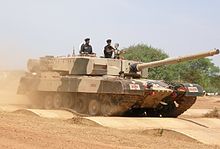
A noted author on the subject of tank design engineering Richard M Ogorkiewicz[5] outlined the following basic engineering sub-systems that are commonly incorporated into tank's technological development:
- Mobility of tanks (through chassis design)
- Tank Engines
- Tank Transmissions
- Suspensions and Running gear
- Soil-Vehicle Mechanics
- Tank guns and Ammunition
- Ballistics and Mechanics of Tank Guns
- Vision and Sighting Systems
- Illuminating and Night Vision Systems
- Fire Control Systems for main and auxiliary weapons
- Gun Control Systems
- Guided Weapons
- Armour Protection
- Configuration of Tanks
To the above can be added unit communication systems and electronic anti-tank countermeasures, crew ergonomic and survival systems (including flame suppression), and provision for technological upgrading. Most tank designs have rarely survived their entire service life without some upgrading or modernisation, particularly during wartime, including some that changed almost beyond recognition, such as the latest Israeli Magach versions.
The characteristics of a tank are determined by the performance criteria required for the tank. The obstacles that must be traversed affect the vehicles front and rear profiles. The terrain that is expected to be traversed determines the track ground pressure that may be allowed to be exerted for that particular terrain.[6]
Offensive capabilities

The main weapon of all modern tanks is a single, large-calibre gun mounted in a fully traversing turret weapon mount. The typical tank gun is a smoothbore weapon capable of firing armor-piercing kinetic energy penetrators (KEP), also known as armour-piercing discarding sabot (APDS), and/or armour piercing fin stabilised discarding sabot (APFSDS) and high explosive anti-tank (HEAT) shells, and/or high explosive squash head (HESH) and/or anti-tank guided missiles (ATGM) to destroy armoured targets, as well as high explosive (HE) shells for engaging soft targets or fortifications. Canister shot may be used in close or urban combat situations where the risk of hitting friendly forces with shrapnel from HE rounds is unacceptably high.[7]
A gyroscope is used to stabilise the main gun, allowing it to be effectively aimed and fired at the "short halt" or on the move. Modern tank guns are also commonly fitted with insulating thermal jackets to reduce gun-barrel warping caused by uneven thermal expansion, bore evacuators to minimise fumes entering the crew compartment and sometimes muzzle brakes to minimise the effect of recoil on accuracy and rate of fire.
Traditionally, target detection relied on visual identification. This was accomplished from within the tank through telescopic periscopes; occasionally however, tank commanders would open up the hatch to view the outside surroundings, which improved situational awareness but incurred the penalty of vulnerability to sniper fire, especially in jungle and urban conditions. Though several developments in target detection have taken place especially recently, these methods are still common practice.

In some cases spotting rifles were used confirm proper trajectory and range to a target. These spotting rifles were mounted co-axially to the main gun, and fired tracer ammunition ballistically matched to the gun itself. The gunner would track the movement of the tracer round in flight, and upon impact with a hard surface, it would give off a flash and a puff of smoke, after which the main gun was immediately fired. However these have been mostly superseded by laser rangefinding equipment.
Modern tanks also use sophisticated light intensification and thermal imaging equipment to improve fighting capability at night, in poor weather and in smoke. The accuracy of modern tank guns is pushed to the mechanical limit by computerised fire-control systems. A fire-control system uses a laser rangefinder to determine the range to the target, a thermocouple, anemometer and wind vane to correct for weather effects and a muzzle referencing system to correct for gun-barrel temperature, warping and wear. Two sightings of a target with the range-finder enable calculation of the target movement vector. This information is combined with the known movement of the tank and the principles of ballistics to calculate the elevation and aim point that maximises the probability of hitting the target.
Usually, tanks carry smaller calibre armament for short-range defence where fire from the main weapon would be ineffective, for example when engaging infantry, light vehicles or aircraft. A typical complement of secondary weapons is a general-purpose machine gun mounted coaxially with the main gun, and a heavier anti-aircraft machine gun on the turret roof. These weapons are often modified variants of those used by infantry, and so utilise the same kinds of ammunition.
Countermeasures
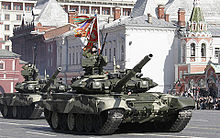
1: Composite armour in the turret
2: Third generation Kontakt-5 ERA
3: Shtora-1 countermeasures suite.
The measure of a tank's protection is the combination of its ability to avoid detection, to avoid being hit by enemy fire, its resistance to the effects of enemy fire, and its capacity to sustain damage whilst still completing its objective, or at least protecting its crew. In common with most unit types, tanks are subject to additional hazards in wooded and urban combat environments which largely negate the advantages of the tank's long-range firepower and mobility, limit the crew's detection capabilities and can restrict turret traverse. Despite these disadvantages, tanks retain high survivability against previous-generation rocket-propelled grenades in all combat environments by virtue of their armour.
However, as effective and advanced as armour plating has become, tank survivability against newer-generation (1980s) tandem-warhead anti-tank missiles is a concern for military planners.[8] For example, the RPG-29 was able to (until recently) penetrate the frontal hull armour of the Challenger II[9][10] and also managed to damage a M1 Abrams.[11]
Avoiding detection

A tank avoids detection using the doctrine of CCD: camouflage (looks the same as the surroundings), concealment (cannot be seen) and deception (looks like something else).
Working against efforts to avoid detection is the fact that a tank is a large metallic object with a distinctive, angular silhouette that emits copious heat and noise. Consequently, it is difficult to effectively camouflage a hull-up tank in the absence of some form of cover or concealment (e.g., woods). The tank becomes easier to detect when moving (typically, whenever it is in use) due to the large, distinctive auditory, vibration and thermal signature of its power plant. Tank tracks and dust clouds also betray past or present tank movement. Switched-off tanks are vulnerable to infra-red detection due to differences between the thermal conductivity and therefore heat dissipation of the metallic tank and its surroundings. At close range the tank can be detected even when powered down and fully concealed due to the column of warmer air above the tank and the smell of diesel.
Thermal blankets slow the rate of heat emission and camouflage nets use a mix of materials with differing thermal properties to operate in the infra-red as well as the visible spectrum. Camouflage attempts to break up the distinctive appearance and silhouette of a tank. Adopting a turret-down or hull-down position reduces the visible silhouette of a tank as well as providing the added protection of a position in defilade
The Russian Nakidka camouflage kit was designed to reduce the Optical, Thermal, Infrared, and Radar signatures of a tank, so that acquisition of the tank would be difficult. According to Nii Stali, the designers of Nakidka, Nakidka would reduce the probabilities of detection via "visual and near-IR bands by 30%, the thermal band by 2-3 fold, radar band by 6 fold, and radar-thermal band to near-background levels.[12] "
Armour

To effectively protect the tank and its crew, tank armour must counter a wide variety of antitank threats. Protection against kinetic energy penetrators and high explosive anti-tank (HEAT) shells fired by other tanks is of primary importance, but tank armour also aims to protect against infantry antitank missiles, ATGMs, antitank mines, bombs, direct artillery hits, and (less often) nuclear, biological and chemical threats, any of which could disable or destroy a tank or its crew.
Steel armour plate was the earliest type of armour. The Germans pioneered the use of face hardened steel during World War II and the Soviets also achieved improved protection with sloped armour technology. World War II developments also spelled the eventual doom of homogeneous steel armour with the development of shaped-charge warheads, exemplified by the Panzerfaust and bazooka infantry weapons which were lethally effective, despite some early success with spaced armour. Magnetic mines led to the development of anti-magnetic paste and paint.
British tank researchers took the next step with the development of Chobham armour, or more generally composite armour, incorporating ceramics and plastics in a resin matrix between steel plates, which provided good protection against HEAT weapons. Squash head warheads led to anti-spall armour linings, and KEPs led to the inclusion of exotic materials like a matrix of depleted uranium into a composite armour configuration.

Reactive armour consists of small explosive-filled metal boxes that detonate when hit by the metallic jet projected by an exploding HEAT warhead, causing their metal plates to disrupt it. Tandem warheads defeat reactive armour by causing the armour to detonate prematurely. Modern Reactive armour protects itself from Tandem warheads by having a thicker front metal plate to prevent the precursor charge from detonating the explosive in the reactive armour. Reactive armours can also reduce the penetrative abilities of kinetic energy penetrators by deforming the penetrator with the metal plates on the Reactive armour, thereby reducing its effectiveness against the main armour of the tank.
Grenade launchers which can rapidly deploy a smoke screen, which are opaque to Infrared light, to hide it from the thermal viewer of another tank. The modern Shtora "soft-kill" countermeasure system provides additional protection by interfering with enemy targeting and fire-control systems and jamming of SACLOS guided ATGMs.
Active protection system
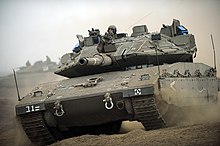
The latest generation of protective measures for tanks are active protection systems, particularly "hard-kill". The Soviet Drozd, the Russian Arena, the Israeli TROPHY and Iron Fist, Polish ERAWA (on PT-91), and the American Quick Kill systems show the potential to dramatically improve protection for tanks against missiles, RPGs and potentially KEP attacks, but concerns regarding a danger zone for nearby dismounted troops remain. As for 2011, only the Israeli Trophy active protection system, installed on the Merkava Mk4, has been combat-proven, as it successfully intercepted RPG rocket and various anti-tank missiles during operational missions on the Gaza Strip border.
Mobility
The mobility of a tank is described by its battlefield or tactical mobility, its operational mobility, and its strategic mobility. Tactical mobility can be broken down firstly into agility, describing the tank's acceleration, braking, speed and rate of turn on various terrain, and secondly obstacle clearance: the tank's ability to travel over vertical obstacles like low walls or trenches or through water. Operational mobility is a function of manoeuvre range; but also of size and weight, and the resulting limitations on options for manoeuvre.
Strategic mobility
Strategic mobility is the ability of the tanks of an armed force to arrive in a timely, cost effective, and synchronized fashion. For good strategic mobility transportability by air is important, which means that weight and volume must be kept within the designated transport aircraft capabilities.
Nations often stockpile enough tanks to respond to any threat without having to make more tanks as many sophisticated designs can only be produced at a relatively low rate. The US Military for instance keeps 6000 MBTs in storage.[13]
Tactical mobility
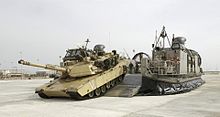
Tank agility is a function of the weight of the tank due to its inertia while manoeuvring and its ground pressure, the power output of the installed power plant and the tank transmission and track design. In addition, rough terrain effectively limits the tank's speed through the stress it puts on the suspension and the crew. A breakthrough in this area was achieved during World War II when improved suspension systems were developed that allowed better cross-country performance and limited firing on the move. Systems like the earlier Christie or later torsion-bar suspension developed by Ferdinand Porsche dramatically improved the tank's cross-country performance and overall mobility.[14]
Tanks are highly mobile and able to travel over most types of terrain due to their continuous tracks and advanced suspension. The tracks disperse the weight of the vehicle over a large area, resulting in less ground pressure. A tank can travel at approximately 40 kilometres per hour (25 mph) across flat terrain and up to 70 kilometres per hour (43 mph) on roads, but due to the mechanical strain this places on the vehicle and the logistical strain on fuel delivery and tank maintenance, these must be considered "burst" speeds that invite mechanical failure of engine and transmission systems. Consequently, wheeled tank transporters and rail infrastructure is used wherever possible for long-distance tank transport. The limitations of long-range tank mobility can be viewed in sharp contrast to that of wheeled armoured fighting vehicles. The majority of blitzkrieg operations were conducted at the pedestrian pace of 5 kilometres per hour (3.1 mph), and that was only achieved on the roads of France.[15]
In the absence of combat engineers, most tanks are limited to fording rivers. The typical fording depth for MBTs is approximately 1 metre (3.3 ft), being limited by the height of the engine air intake and driver's position. Modern tanks such as the Russian T-90 and the German Leopard I and Leopard II tanks can ford to a depth of 3 to 4 metres when properly prepared and equipped with a snorkel to supply air for the crew and engine. Tank crews usually have a negative reaction towards deep fording but it adds considerable scope for surprise and tactical flexibility in water crossing operations by opening new and unexpected avenues of attack.
Amphibious tanks are specially designed or adapted for water operations, but they are rare in modern armies, being replaced by purpose-built amphibious assault vehicles or armoured personnel carriers in amphibious assaults. Advances such as the EFA mobile bridge and MT-55 scissors bridge have also reduced the impediment to tank advance that rivers posed in World War II.[16]
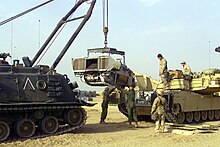
The tank's power plant supplies kinetic energy to move the tank, and electric power via a generator to components such as the turret rotation motors and the tank's electronic systems. The tank power plant has evolved from predominantly petrol and adapted large-displacement aeronautical or automotive engines during World Wars I and II, through diesel engines to advanced multi-fuel diesel engines, and powerful (per unit weight) but fuel-hungry gas turbines in the T-80 and M1 Abrams.
Tank power output in context:
| Vehicle | Power output | Power/weight |
|---|---|---|
| Mid-sized car: Toyota Camry 2.4L | 158 horsepower (118 kW) | 106 hp/tonne |
| Sports car: Lamborghini Murciélago 6.5L | 632 horsepower (471 kW) | 383 hp/tonne |
| Racing car: Formula One car 3.0L | 950 horsepower (710 kW) | 2100 hp/tonne |
| Main battle tank: Leopard 2, M1 Abrams | 1,500 horsepower (1,100 kW) | 24.2, 24.5 hp/tonne |
| Locomotive: SNCF Class T 2000 | 2,581 horsepower (1,925 kW) | 11.5 hp/tonne |
Crew
Most modern tanks most often have four crew members, this being reduced to three depending if an auto-loader is installed, these are the:-
- Commander - The commander is responsible for commanding the tank, most often in conjunction with other tanks and supporting infantry, the commander is provided with all round vision devices rather than the limited ones of the driver and gunner
- Driver - The driver drives the tank, the driver often also serves as the tanks day to day mechanic
- Gunner - The gunner is responsible for laying the gun
- Loader - The loader loads the gun, with a round appropriate to the target, in tanks with auto-loaders this position is omitted.
During history, crew members have varied from just two to a dozen. For example pre WW-II French tanks were noted for having a two man crew, in which the overworked commander had to load and fire the gun in addition to commanding the tank. First World War tanks were developed with immature technologies, in addition to the crew needed to man the multiple guns and machine guns up to four crewmen where needed to drive the tank-the driver who acted as the vehicle commander and who manned the brakes, he would drive through orders to his gears-men, a co-driver to operate the gearbox and throttle, two gears-men one on each track who would steer by setting one side or the other to idle allowing the track on the other side to slew the tank to one side.
With World War II the multi turreted tanks proved impracticable, and as the single turret on a low hull design became standard, crews became standardized around a crew of four or five. In those tanks with a fifth crew member he was most often seated in the hull next to the driver and operated the hull machine gun in addition to acting as a co-driver or radio operator.
Well designed crew stations, giving proper considerations to comfort and ergonomics, are an important factor in the combat effectiveness of a tank, as it limits fatigue and speeds up individual actions.
Command, control and communications
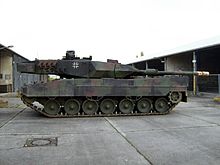
Commanding and coordinating tanks in the field has always been subject to particular problems, particularly in the area of communications, but in modern armies these problems have been partially alleviated by networked, integrated systems that enable communications and contribute to enhanced situational awareness.
Early
Armoured bulkheads, engine noise, intervening terrain, dust and smoke, and the need to operate "buttoned up" are severe detriments to communication and lead to a sense of isolation for small tank units, individual vehicles, and tank crewmen. Radios were not then portable or robust enough to be mounted in a tank, although Morse Code transmitters were installed in some Mark IVs at Cambrai as messaging vehicles.[17] Attaching a field telephone to the rear would became a practice only during the next war. During World War I when these failed or were unavailable, situation reports were sent back to headquarters by some crews releasing carrier pigeons through loopholes or hatches[18] and communications between vehicles was accomplished using hand signals, handheld semaphore flags which continued in use in the Red Army/Soviet Army through the Second and Cold wars, or by foot or horse mounted messengers.[19]
Modern
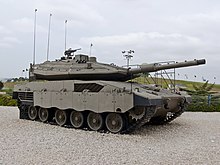
On the modern battlefield an intercom mounted in the crew helmet provides internal communications and a link to the radio network, and on some tanks an external intercom on the rear of the tank provides communication with co-operating infantry. Radio networks employ radio voice procedure to minimise confusion and "chatter".
A recent development in AFV equipment and doctrine is the increased integration of information from the fire control system, laser rangefinder, Global Positioning System and terrain information via hardened military specification electronics and a battlefield network to display all known information on enemy targets and friendly units on a monitor in the tank. The sensor data can be sourced from nearby tanks, planes, UAVs or, in the future infantry (such as the US Future Force Warrior project). This improves the tank commander's situational awareness and ability to navigate the battlefield and select and engage targets. In addition to easing the reporting burden by automatically logging all orders and actions, orders are sent via the network with text and graphical overlays. This is known as Network-centric warfare by the US, Network Enabled Capability (UK) or Digital Army Battle Management System צי"ד (Israel).
Etymology
The word tank was first applied to the British "landships" in 1915, before they entered service, to keep their nature secret. Several explanations of the precise origin of the term have been suggested, including:
- It arose in British factories making the hulls of the first battle tanks: workmen and possible spies were to be given the impression they were constructing mobile water tanks for the British Army, thus keeping the production of a fighting vehicle secret.[20]
- The term was first used in a secret report on the new motorised weapon presented to Winston Churchill, then First Lord of the Admiralty, by British Army Lt.-Col. Ernest Swinton.[21]
- Winston Churchill's biography states, "To disguise the device, drawings were marked 'water carriers for Russia.' When it was pointed out this might be shortened to "WCs for Russia," the drawings were relabelled "water tanks for Russia." Eventually the weapon was just called a tank.[22] (In fact, the prototype was referred to as a water-carrier for Mesopotamia [see below]. The Russian connection is that some of the first production Tanks were labelled in Russian "With Care to Petrograd," as a further security measure.)
In his autobiography, Albert Stern (founder member of the Landships Committee, later head of the Mechanical Warfare Supply Department) says that on or shortly after October 20, 1915, "Mr. Macnamara then suggested, for secrecy's sake, to change the title of the Landships Committee. Mr. d'Eyncourt agreed that it was very desirable to retain secrecy by all means, and proposed to refer to the vessel as a "Water Carrier." In Government offices, committees and departments are always known by their initials. For this reason I, as Secretary, considered the proposed title totally unsuitable.* In our search for a synonymous term, we changed the word "Water Carrier" to "Tank," and became the "Tank Supply" or "T.S." Committee. That is how these weapons came to be called "Tanks," and the name has now been adopted by all countries in the world."[23] Swinton states, "Since the 24th December, 1915, the Tank has always been known as such; and there has been no confusion as to its nomenclature."[24] His Notes on the Employment of Tanks, in which he uses the word throughout, was published in January 1916.
(* The initials W.C. are a British abbreviation for a water closet; in other words, a toilet. Unfortunately, later in the War a number of Mk IV Tanks were fitted with grapnels to remove barbed wire. They were designated "Wire Cutters" and had the large letters "W.C." painted on their rear armour.)
Stern says, "we changed the word." Lt.-Col. Swinton also claims that it was his suggestion at that meeting.[25] However, in July 1918 the following explanation was published in Popular Science Monthly: "Because a fellow of the Royal Historical Society has unintentionally misled the British public as to the origin of the famous "tanks," Sir William Tritton, who designed and built them, has published the real story of their name ... Since it was obviously inadvisable to herald "Little Willie's" reason for existence to the world he was known as the "Instructional Demonstration Unit." "Little Willie's" hull was called in the shop orders a "water carrier for Mesopotamia;" no one knew that the hull was intended to be mounted on a truck. Naturally, the water carrier began to be called a "tank." So the name came to be used by managers and foremen of the shop, until now it has a place in the army vocabulary and will probably be so known in history for all time." It may be that d'Eyncourt was aware of this practice and therefore suggested the name to the Landships Committee. In any event, the word was in use by members of the Committee several months before production orders had been placed.[26]
By "all countries in the world," Stern is not entirely correct. The word "tank" was adopted in most languages, including Russian. Some countries, however, use different names. In France, in 1917 the second nation to employ tanks, the use of an English term was rejected and they are known as chars d'assaut ("assault vehicles") or simply chars. In Germany, tanks are usually referred to as "Panzer" (lit. "armour"), a shortened form of the full term "Panzerkampfwagen", literally "armoured fighting vehicle". In the Arab world, tanks are called Dabbāba (after a type of siege engine). In Italian, a tank is a "carro armato" (lit. "armed wagon"), without reference to its armour. The Scandinavian countries use the term stridsvogn (Norway) or stridsvagn (Sweden) ("chariot", lit. "battle wagon"). Polish name czołg is derived from verb czołgać się meaning "to crawl" depicting the way of machine's movement and its speed.
See also
|
|
Notes
- ^ von Senger and Etterlin (1960), The World's Armored Fighting Vehicles, p.9.
- ^ Coox (1985), p. 579, 590, 663
- ^ Cite error: The named reference
House1984was invoked but never defined (see the help page). - ^ Tranquiler, Roger, Modern Warfare. A French View of Counterinsurgency, trans. Daniel Lee,
Pitting a traditional combined armed force trained and equipped to defeat similar military organisations against insurgents reminds one of a pile driver attempting to crush a fly, indefatigably persisting in repeating its efforts.
[page needed] - ^ Technology of Tanks, Richard M Ogorkiewicz, Jane's Information Group, 1991[page needed]
- ^ Journal of the United Service Institution of India, Volume 98, United Service Institution of India, 1968, p. 58, retrieved 4 April 2011
- ^ USA Today (2005), Tanks adapted for urban fights they once avoided
- ^ BBC News (2006) Tough lessons for Israeli armour
- ^ "Defence chiefs knew 'invincible' tank armour could be breached", Daily Mail, 24 April 2007
- ^ Sean Rayment (May 12, 2007 *). "MoD kept failure of best tank quiet". Sunday Telegraph.
{{cite news}}: Check date values in:|date=(help) - ^ Michael R. Gordon (May 21, 2008). "Operation in Sadr City Is an Iraqi Success, So Far". The New York Times.
- ^ [1][dead link]
- ^ John Pike. "M1 Abrams Main Battle Tank". Globalsecurity.org. Retrieved 2009-06-09.
- ^ Deighton (1979), Blitzkrieg, From the rise of Hitler to the fall of Dunkirk, pp. 154
- ^ Deighton (1979), Blitzkrieg, From the rise of Hitler to the fall of Dunkirk, p.180
- ^ Deighton (1979), Blitzkrieg, From the rise of Hitler to the fall of Dunkirk, pp.234-252
- ^ Macksey, K., Tank vs Tank, Grub Street, London, 1999, p. 32
- ^ Fletcher, D., British Mark I Tank 1916, Osprey, p. 19
- ^ Wright 2002, Tank: The Progress of a Monstrous War Machine, p. 48, "To the extent that they communicated at all, the tank crews did so by squeezing carrier pigeons out through a hole in a gun sponson, by brandishing a shovel through the manhole,mili or by frantically waving coloured discs in the air."
- ^ Cite error: The named reference
Willmott2003was invoked but never defined (see the help page). - ^ Barris (2007), Victory at Vimy: Canada Comes of Age April 9–12, 1917, p.116
- ^ Gilbert (1991), Churchill: A Life, p.298.
- ^ Tanks 1914-1918; The Log Book of a Pioneer. Hodder & Stoughton, 1919[page needed]
- ^ Eyewitness; being personal reminiscences of certain phases of the Great War ... By Ernest Dunlop Swinton[page needed]
- ^ Over My Shoulder; The Autobiography of Major-General Sir Ernest D. Swinton. 1951[page needed]
- ^ Eyewitness; being personal reminiscences of certain phases of the Great War. Ernest Dunlop Swinton[page needed]
References
- "Electric/Hybrid Electric Drive Vehicles for Military Applications", Military Technology (9/2007), Moench Verlagsgesellschaft mbH: 132–144, 2007
{{citation}}: Cite has empty unknown parameter:|coauthors=(help); Unknown parameter|month=ignored (help) - Barris, Ted (2007), Victory at Vimy: Canada Comes of Age April 9–12, 1917, Thomas Allen Publishers, p. 116, ISBN 0-88762-253-4;
{{citation}}: Check|isbn=value: invalid character (help)CS1 maint: extra punctuation (link) - Cawthorne, Nigel (2003), Steel Fist: Tank Warfare 1939-45, London: Arcturus Publishing Ltd., ISBN 0-572-02872-5
- Churchill, Winston (1992), The World Crisis (Abridged), Canada & New York: Macmillan Publishing Company, ISBN 0-684-19453-8
- Cooper, Matthew and Lucas, James (1979), Panzer: The Armoured Force of the Third Reich, Book Club Associates
{{citation}}: CS1 maint: multiple names: authors list (link) - Coox, Alvin D. (1985), Nomonhan; Japan against Russia, 1939, Stanford University Press, ISBN 0-8047-1160-7
- Deighton, Len (1979), Blitzkrieg: From the rise of Hitler to the fall of Dunkirk, Fakenham: Fakenham Press Limited, ISBN 0-224-01648-2
- DiNardo, Richard L. (January 1986), "The First Modern Tank: Gunther Burstyn and His Motorgeschutz", Military Affairs, 50, No.1 (1), JSTOR: Society for Military History: 12–15, JSTOR 1988528
- Col. Eshel, David (2007), Assessing the performance of Merkava Tanks, Defense Update, retrieved 2008-05-16
- Forty, George (2004), Tank Warfare in World War II, London: Constable & Robinson Ltd, ISBN 1-84119-864-1
- Forty, George (2006), The World Encyclopedia of Tanks & Armoured Fighting Vehicles, Lorenz Books, ISBN 0-7548-1741-5
- Gilbert, Sir Martin (1991), Churchill: A Life, Thomas Allen Publishers, p. 298, ISBN 0-7624-2081-2
- Goldman, Stuart D. (2012), Nomonhan 1939; The Red Army's Victory That Shaped World War II, Naval Institute Press, ISBN 978-1-59114-329-1
- Goodell, Brad (2007), "Electrothermal Chemical (ETC) Armament System Integration Into a Combat Vehicle", IEEE Transaction on Magnetics, 43 (1), IEEE: 4, doi:10.1109/TMAG.2006.887524
{{citation}}: Cite has empty unknown parameter:|coauthors=(help); Unknown parameter|month=ignored (help) - Hilmes, Rolf (2004), "Arming Future MBTs - Some Considerations", Military Technology (12/2004), Moench Verlagsgesellschaft Mbh: 4
{{citation}}: Cite has empty unknown parameter:|coauthors=(help); Unknown parameter|month=ignored (help) - House, Jonathan M. (1984), Toward Combined Arms Warfare: A Survey of 20th-Century Tactics, Doctrine, and Organization, United States Government Printing, OCLC 464265702, retrieved 2008-05-18
{{citation}}: Invalid|ref=harv(help) - Hunnicutt, R. P. (1984), Patton: A History of the American Main Battle Tank, Presidio, ISBN 0-89141-230-1
- Komarow, Steven (2005-03-29), Tanks adapted for urban fights they once avoided, USA Today, retrieved 2008-05-16
- Komarow, Steven (2005-03-29), Tanks take a beating in Iraq, USA Today, retrieved 2008-05-16
- Koschier, Angelo V. (2000), "Advantages of the LV100 as a Power Producer in a Hybrid Propulsion System for Future Fighting Vehicles", Journal of Engineering for Gas Turbines and Power, 122 (October 2000): 693–698, doi:10.1115/1.1287585
{{citation}}: Unknown parameter|coauthors=ignored (|author=suggested) (help) - Manrique, Jose (2006), Las Armas de la Guerra Civil Espanola (in Spanish), 28002 Madrid; La Los Libros, ISBN 84-9734-475-8
{{citation}}: Unknown parameter|coauthor=ignored (|author=suggested) (help) - Marcus, Jonathan (2006-08-15), Tough lessons for Israeli armour, BBC News, retrieved 2008-05-26
- McDonald, Colin F. (1990), "Gas Turbine Recuperator Renaissance", Heat Recovery Systems & CHP, 10 (1), Pergamon Press: 1–30, doi:10.1016/0890-4332(90)90246-G
{{citation}}: Cite has empty unknown parameter:|coauthors=(help) - Pengelley, Rupert (1989), "A new era in tank man armament: The options multiply", Janes International Defense Review (November 1989): 1521–1531
{{citation}}: Cite has empty unknown parameter:|coauthors=(help) - Regan, Geoffrey (1993), The Guinness Book of More Military Blunders, London: Guinness Publishing, ISBN 0-85112-961-7
- Sharoni, Asher H. and Bacon, Lawrence D., The Future Combat System (FCS): Technology Evolution Review and Feasibility Assessment (PDF), GlobalSecurity.org, retrieved 2008-05-26
{{citation}}: CS1 maint: multiple names: authors list (link) - Starry, Donn A. GEN: Mounted Combat in Vietnam. Vietnam Studies; Department of the Army, Washington, D.C. 1978.
- Thompson, William J. and Sorvig, Kim (2000), Sustainable Landscape Construction: A Guide to Green Building Outdoors, Island Press, p. 51, ISBN 1-55963-646-7
{{citation}}: CS1 maint: multiple names: authors list (link) - Time Life Books editors (1990), The Armored Fist, Alexandria, Virginia: Time-Life Books, ISBN 0-8094-8609-1;, ISBN 0-8094-8704-7
{{citation}}:|author=has generic name (help); Check|isbn=value: invalid character (help)CS1 maint: extra punctuation (link) - Chewed Up, Alexandria, Virginia: Time magazine, 5 April 1937, retrieved 2008-05-16
- Tomes, Robert R. (Spring, 2004), "Relearning Counterinsurgency Warfare", Parameters, Vol. XXXIV, (No. 1, ), US Army War College: 16–28, archived from the original on 2008-05-14, retrieved 2008-05-26
{{citation}}:|issue=has extra text (help);|volume=has extra text (help); Check date values in:|date=(help); Cite has empty unknown parameter:|coauthors=(help)CS1 maint: extra punctuation (link) - von Senger und Etterlin, Dr. F. M. (1960), The World's Armoured Fighting Vehicles, London: Macdonald & Co. (Publishers) Ltd.
- Wickert, Matthias (2007), "Electric Armor Against Shaped Charges: Analysis of Jet Distortion With Respect to Jet Dynamics and Current Flow", IEEE Transaction on Magnetics, 43 (1), IEEE: 426–429, doi:10.1109/TMAG.2006.887650
{{citation}}: Cite has empty unknown parameter:|coauthors=(help); Unknown parameter|month=ignored (help) - Willmott, H.P. (2003), First World War, Dorling Kindersley, ISBN 1-4053-0029-9;
{{citation}}: Check|isbn=value: invalid character (help)CS1 maint: extra punctuation (link) - Wright, Patrick (2002), Tank: The Progress of a Monstrous War Machine, ISBN 978-0-670-03070-5
- Xiaopeng, Li (2007), "Multiprojectile Active Electromagnetic Armor", IEEE Transaction on Magnetics, 43 (1): 460–462, doi:10.1109/TMAG.2006.887581
{{citation}}: Unknown parameter|coauthors=ignored (|author=suggested) (help); Unknown parameter|month=ignored (help) - Zaloga, Steven J. and Grandsen, James (1984), Soviet Tanks and Combat Vehicles of World War Two, London: Arms and Armour Press, ISBN 0-85368-606-8
{{citation}}: CS1 maint: multiple names: authors list (link) - Zaloga, Steven J., Kinnear, Jim, Aksenov, Andrey & Koshchavtsev Aleksandr (1997), Soviet Tanks in Combat 1941–45: The T-28, T-34, T-34-85, and T-44 Medium Tanks, Hong Kong: Concord Publication, ISBN 962-361-615-5
{{citation}}: CS1 maint: multiple names: authors list (link)
Further reading
- Macksey, Kenneth (1976), Tank Warfare, A History of Tanks in Battle, London: Panther, ISBN 0-586-04302-0
- Macksey, Kenneth and Batchelor, John H. (1970), Tank: A History of the Armoured Fighting Vehicle, New York: Scribner, ISBN 0-345-02166-5;, ISBN 0-684-13651-1
{{citation}}: Check|isbn=value: invalid character (help)CS1 maint: extra punctuation (link) CS1 maint: multiple names: authors list (link) - Ogorkiewicz, Richard M. (1968), Design and Development of Fighting Vehicles, London: MacDonald, ISBN 0-356-01461-4
- Ogorkiewicz, Richard M. (1970), Armoured Forces: A History of Armoured Forces and Their Vehicles, Arms & Armour Press, ISBN 0-85368-049-3
- Ogorkiewicz, Richard M. (1991), Technology of Tanks, Coulsdon, Surrey: Jane's Information Group, ISBN 0-7106-0595-1
- Weeks, John (1975), Men Against Tanks: A History of Anti-Tank Warfare, New York: Mason Charter, ISBN 0-88405-130-7;
{{citation}}: Check|isbn=value: invalid character (help)CS1 maint: extra punctuation (link)
External links
- Articles on Modern tanks
- The Burstyn tank Landships has additional information and a model of Günther Burstyn's Motorengeschütz.
- OnWar's Tanks of World War II Comprehensive specifications and diagrams of World War II tanks.
- Achtung Panzer History of tanks and people of the Panzertruppe.
- Tanks of World War I
- Allied tank aces of World War II
Template:Link GA Template:Link FA Template:Link FA Template:Link FA Template:Link FA Template:Link FA Template:Link FA Template:Link FA Template:Link FA Template:Link FA Template:Link FA Template:Link GA
